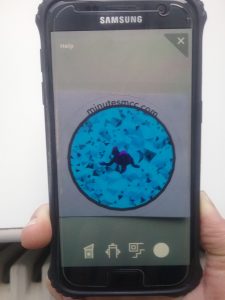If circus is human, do circus shows lose their humanity when we force technology into them?
“Join The Circus?” the Quand La Foule Devient Cirque app on my phone asks me as the Les Minutes Completement Cirque performance begins. I click join. Error. I must first give the app permission to use my location, camera, microphone, and pictures. I furiously click into the settings as it instructs, while the performance goes on just ahead. The instructions said to find the permissions in the settings, but there is no option for permissions. I go back to the home page and click on settings a few more times, looking up briefly to see what I’m missing. The performers, wearing LED headsets and smart phone chest armor, look like they’re having fun. I want to join in. I delete the app and redownload it. It finally loads, but by now the performers have moved on. I scurry to rejoin them.
The app says to freeze, but everyone’s phone around me says to freestyle. I guess the only thing that froze was my app. I close and re-open it. It works now, but the instructions seem to be lagging. We freestyle, but the performers tell us to crouch down. Instead of carelessly having fun with the performers, we all look confusedly at our phones. The performers give us much better instructions than the app, but we all struggle to continue using it. The disjointed performance continues down the street.
The app tells me that it’s time to interact with an acrobat, I must scan them for a surprise. I use my phone’s camera on the performer’s hand. The design on the acrobat’s hand looks blue on my phone. I click it. Nothing happens. I click it a few more times. The performer asks me if I see it. I don’t know what I’m supposed to see. By now a child is looking on my phone too. I click it a few more times, but the performer tells me no. I don’t know what I’m supposed to do. Finally, a tiny acrobat flips on my phone screen. All of this effort for that? The performer thanks me. Probably because no one takes the time to figure it out. I feel that this was a missed opportunity for the performer to meaningfully interact with me as an audience member. I was technically engaging with the performer, but I was staring at my phone the entire time. The interaction felt completely meaningless.


In the park, I sit down and wait for the Numeriques part of the performance to begin. My app tells me to add to the symphony with my phone. I flick my phone a few times as the app instructs, and noises are projected out. The app tells me to enjoy the show and tag my pictures with #qlfdc. I close the app to take pictures, only later realizing that there were additional instructions during the show when I saw other audience members following it. Ops.

This experience made me wonder where the line between technology for enhancing narrative and technology for spectacle is. Besides the technical difficulties, it felt like the app took away from the experience. There were plenty of people that didn’t have the app that interacted with the performers the same way or better than those of us that did. Instead of watching what was happening, I was looking at my phone for instructions (which were normally not accurate anyways).
Despite listening to a workshop earlier in the week about the app and performance, I still didn’t entirely understand how to use the Quand le Foule Devient Cirque app. As someone who works with technology, I like to think that I pick up on how to use technology relatively quickly. I did not feel that was the case here. In the workshop, the creators of this performance told us that they had issues with people closing the app to take pictures. Even though I had heard this just days before, I closed the app to take pictures because the cues in the app made me think that it was the end. I didn’t realize it until later that this was the moment they were probably talking about. The app didn’t make me feel like I was a part of the performance. Even when interacting with a performer, I felt more connected to my phone. I’ve seen Les Minutes four other years during MCC. My previous experiences felt more authentic and had performers and audience members making meaningful connections.
Technology is cold and emotionless. If a circus brings in someone who specializes in a technology, but who doesn’t have a background in performance and human connection, do we risk the technology being just that—technology? Technology in performance without humanity is just technological spectacle.
This left me wondering, was this Minutes performance created as a spectacle? The creators of the performance indicated that they wanted to include the app because everyone uses apps on a regular basis. Do we add these things to performances to give the impression that we’re relevant? Or maybe as a buzz word to funders?
The draw of circus is a suspension of disbelief and incredible human feats. Like it or not, technology has changed the ways in which people consume art and entertainment. The answer is not to shun technology in circus, or to randomly include it and build a show around it. One of the things that separates circus from other forms of art and entertainment is the human performer. Losing the performer to technology leaves circus shows as nothing more than what you can find at an EDM festival. Technology is a tool, not an end means. The success of future shows will be in using technology to tell new stories in innovative ways—but with the human performer always at the heart of it.









